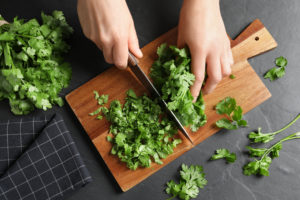
Cilantro (Coriandrum sativum)
January 2022
This more sensitive annual herb gives us edible leaves, stems, flowers, and seeds. Did you know that cilantro and coriander are the same plant? “Cilantro” refers to the leaves and stems whereas “coriander” refers to the seeds. Both pack a unique flavor and are used in kitchens around the world.
How to Grow:
- Start from seed: Cilantro is a cool season crop preferring 50-85F. Plant seeds outside from Feb-Mar for a spring harvest and in late Sept for a fall harvest (Central and Eastern NC). Space the seeds 2-4 inches apart in a sunny, well-draining location. Water regularly.
Plant Part Tips:
- Lower Leaves: the outer lower leaves are most flavorful and best used fresh in recipes. Cut stems that are 4-6 inches long near the base of the plant just before mealtime. Removing these older leaves encourages the plant to “stay young” by focusing energy on new leaves.
- Upper Leaves: You may notice thin fern-like leaves starting to grow as the weather warms. Your plant wants to bolt upwards to produce flowers. Avoid bolting as long as possible by cutting out these leaves at their base. They are also edible but more bitter.
- Flowers: When your cilantro eventually bolts, it is okay and even a good thing. The white to pink flowers attract beneficial insects like butterflies and predatory hoverflies. The flowers can also replace leaves in a recipe for a more mild flavor.
- Seeds (a.k.a. Coriander): If you’d like to harvest the seeds, be sure to allow flowering and pollination. When the seed heads look brown, cut them off, hang upside-down in a paper bag in a cool dry place, and let the bag catch mature seeds as they fall. After fully dried out, store your coriander seeds in an airtight container.
How to use fresh cilantro:
Cilantro makes an excellent addition to many dishes thanks to its fresh and vibrant flavor. It can be finely chopped and incorporated into mixed dishes, or sprinkled on top for added flavor as a garnish.


How to prepare cilantro:
- Thoroughly rinse the cilantro stems and pat dry with a towel. Allow cilantro to completely dry before using.
- Cilantro leaves provide the most flavor. Remove the leaves by picking them off the stem. Young children can help with this easy kitchen task. Alternatively, you can cut the leaves off the top of the cilantro bunch in one chop, and remove the stems by hand.
- Next, chop the cilantro to your liking. Bunch leaves together in a pile and roughly chop for a garnish or topping. Finely chop if incorporated into a mixed dish like salsa or sauce.
- Want to use the stems and the leaves? Turn the cilantro into a pesto or sauce (see recipe below) to use both the leaves and stem.
How to store fresh cilantro:
- Place fresh cilantro stems in a glass of water. Cover the leaves with plastic wrap or a bag to keep them fresh. Store in the refrigerator for up to 1 week.
- Store already chopped cilantro leaves in an air-tight container in the refrigerator. Place a paper towel in the bottom of the container to absorb extra moisture. Change out the paper towel every few days to keep chopped cilantro fresh. Make sure that cilantro is fully dry before storing. Cilantro leaves may turn brown and soggy if stored wet.
- Have lots of leftover cilantro? Mix chopped cilantro leaves with some water or oil and pour into an ice cube tray. Freeze cilantro cubes and add to cooked dishes for extra flavor, year round.

Recipes:
1. Use freshly chopped cilantro in this Poe Center recipe, Peach-Mango Salsa.
Ingredients:
-
- 1 mango
- 2 medium peaches
- 1 jalapeno (seeds removed)
- ½ bunch cilantro
- 1 red bell pepper
- 1 medium tomato
- 1 lime
- ½ red onion
- 1 clove garlic
- salt and pepper to taste

Instructions:
-
- Dice mango, peaches, bell pepper, tomato, and red onion into uniform pieces. Combine into a medium sized bowl, including any juices as a result of chopping.
- Finely chop jalapeno and cilantro. Mince garlic. Add into the bowl and stir until combined.
- Squeeze the juice from 1 lime into the bowl. Season with salt and pepper according to your taste preference. Refrigerate until ready to serve.
- Note: you can adjust the flavors of this recipe by adding more garlic, onion, cilantro, or jalapeno depending on your preference.
2. Try out coriander in this Roasted Falafel Chickpea recipe.
3. Use both the cilantro leaves and stem in this Cilantro-Herb Pesto.
Follow our Garden to Kitchen blog each month for great tips
and insights on growing and cooking edible plants:
Get this great content delivered directly to your inbox.
Subscribe to our monthly nutrition email newsletter.
